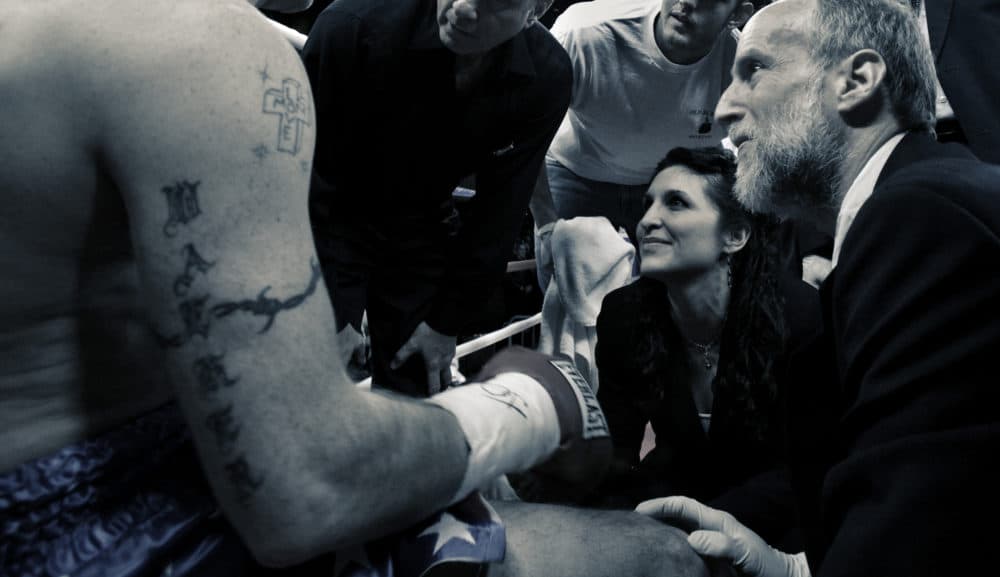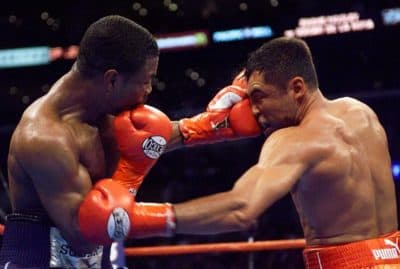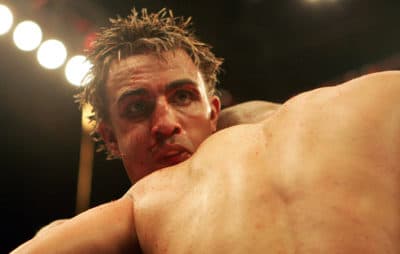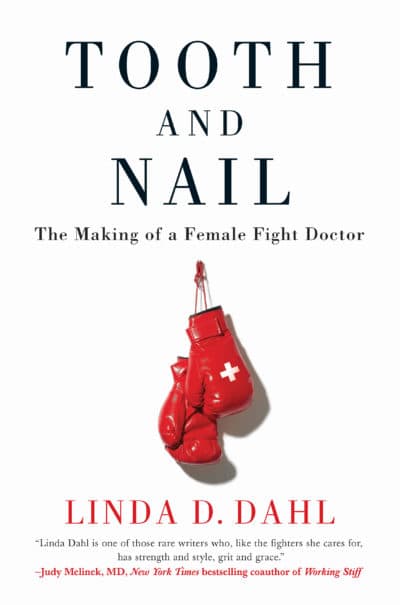Advertisement
Linda Dahl's Fight For Acceptance As A Fight Doctor

Linda Dahl moved to the Bronx in 1998 to begin a medical residency. There, she treated victims of gun and knife violence every day.
"I would come home from the hospital, you know, after having experienced real violence," Dahl says. "And I would be met with these images of more violence at home."
Dahl’s husband was an avid boxing fan. She began watching televised matches with him. In June of 2000, they watched the welterweight title fight between defending champion Oscar De La Hoya and Shane Mosley on pay-per-view. Dahl was fascinated by Mosley.
"And he was so quiet and reserved and almost gracious," Dahl says.
In a pre-fight interview, Mosley asked a rhetorical question: "Why be afraid of what you want?" That resonated with Dahl.
"Very much so. Because I don’t think I really thought about the world in those terms," she says. "I wasn’t thinking about what I wanted. I was just thinking about what I was obligated to do. That’s from a first-generation immigrant mentality. But also, as a physician, it was all about responsibility."
Dahl was an easy target in the highly competitive — and mostly male — world of surgical residency. Her upbringing in a Syrian family trying — and often failing — to assimilate in Minot, North Dakota, imbued her with a go-along-to-get-along approach to life. She was ill-prepared for the power struggles between residents.
Boxing As Inspiration

Mosley upset De La Hoya for the title.
"And it was incredible," Dahl says. "That fight was amazing."
Boxing captured Linda Dahl’s imagination. She began thinking about what she really wanted: a happy marriage, respect, professional accomplishment, a better-paying job. By 2004, she was divorced and working in a well-established private practice on the Upper East Side. One day, she asked a patient about his line of work. She did that at the beginning of every exam.
"And he mentioned that he used to work for HBO Sports," Dahl says. "And for some reason, it just clicked in my head, and I immediately just blurted out, 'I want to be a fight doctor!' To which he responded, 'Why? Why would you want to do this?' And he said, 'All right, I’m gonna make some phone calls. Because they’d love the idea of a woman doing this.' "
"They" were the New York State Athletic Commission. Dahl immediately submitted her paperwork.
Advertisement
"And then nine months later," Dahl says "I got a phone call with an assignment."
At The Fights
Dahl would work her first match as a fight doctor at a charity event on Oct. 14, 2004.
"I was ringside, and it was incredible. I was terrified," Dahl says. "The surprising part of it was that I felt so excited by the hitting and the sound of the hitting. And the look in their eye, and how they transformed into these different people when they were in the ring.
"I had never even seen a live fight. I knew nothing about the rules. I didn’t even know what fight doctors did."
She leaned over to one of the other fight doctors and asked for help.
"I kept saying, 'Is there a book? Is there a training manual?' And he said, 'No, you just kinda show up and the guys will teach you. It’s all on-the-job training.' "
Over the following months, Dahl got to know many of the boxers she protected in the ring.
"I loved them. They reminded me a lot of the boys and young men that I met in the Bronx," Dahl says. "They had a way to channel whatever difficult circumstances they grew up in, in the ring. And they all came from really awful circumstances. There was just so much compassion for each other. They were so open to connecting with … I think a lot of them saw me as a maternal figure."

The Struggle For Acceptance
But the fighters were sometimes squeamish about being examined by a female doctor. Like the time when Dahl worked the Curtis Stevens/Marcos Primera fight in July 2006.
"Curtis dealt Marcos a low blow," Dahl says. "And it created this traumatic hernia. And Marcos was crawling across the ring, screaming in agony. And it really reminded me of cancer patients, and the kind of screaming that I would hear in the hospital when people were going through treatment or dying. It was horrifying.
"The only way his hernia could be checked was if the doctor at his corner, who happened to be me, checked him at the ring. But, because I’m a woman, he didn’t want me to."
Marcos Primera was given a five minute break by the referee. Primera got up from the canvas and continued the fight. He knocked Stevens out in the eighth round.
Dahl had been ignored. She still hadn’t earned full respect from the community of fight doctors. People in the boxing world made occasional unwanted passes. For decades, Dahl had been what she describes as a "martyr." She often suffered in silence.
The Dominatrix
And then she met a patient with a sinus infection who would help her change that. As always, Dahl asked what she did for a living.
"And she didn’t want to tell me at first," Dahl says. "And then, she said, 'OK, I’m a dominatrix.'
"And I couldn’t believe my ears. And I just found it so fascinating. She was explaining how it wasn’t about sex. It was about power. And for her, it was about using her sexuality and sensuality to gain power and control over a man. I couldn’t even wrap my head around it. Because I had spent my whole life trying to divorce myself from my gender and my sexuality. Because there was just no place for it. It always kept getting in the way."
"I changed into these very tight, black suits with patent leather stiletto boots. And low-cut tops, and my hair was down, lots of makeup and black latex gloves. It worked."
Dr. Linda Dahl
Dahl did a makeover. She began showing up at fights with a new persona.
"I changed my costume," Dahl says with a giggle. "I used to wear just kind of standard, basic business suits, sort of higher neck shirts, flat shoes, pony tails. And I changed into these very tight, black suits with patent leather stiletto boots. And low-cut tops, and my hair was down, lots of makeup and black latex gloves.
"It worked."
Dahl wore her new outfits to the office and to the ring. And people treated her differently. She began to get more and better fight assignments. She had frequent conversations in her mind with her alter-ego, which she called "The Dom."
Taking Charge
And then came the fight that she says changed everything for her: Miguel Cotto versus Paulie Malignaggi in 2006.

"Malignaggi sustained an injury that was right in my specialty," Dahl says. "He sustained something called an orbital blowout fracture. This was a direct blow with the fist right into the eye socket. The weakest bone in that framework is the bone that holds up the eyeball. And, immediately, I knew what it was. And so I ran up to one of the other doctors. And I said, 'He can’t keep fighting. He’s going to go blind. He can’t keep getting hit in the face.' "
But he did. For the final six rounds of the 12-round fight, Malignaggi was hit in the face. A lot. Miguel Cotto won by unanimous decision.
"And so, we were in the dressing room, and Paulie’s really upset because he sees himself for the first time," Dahl says. "And then another doctor comes in, and he says, 'I’m his personal doctor, and I’m taking care of him!' And so I started explaining the injury, and he just was clueless. And then I did something that I’d never done before. I said, 'What kind of doctor are you?' And he said, 'I’m his hand doctor.' And I said, 'All right, this is nothing to do with you.' And I just kinda took charge."
Dahl sent Malignaggi to the emergency room. She gave her diagnosis to the attending physician, and the boxer’s eyesight was saved.

"And it felt kind of amazing," Dahl says. "Because it was just medical. Which is really all I wanted to begin with. I mean, going through that whole role-playing as a dominatrix is really just to get me to a place where everyone would listen to me as a doctor.
"And then, after that, it was very different. I mean, the other doctors were asking me to teach them."
Post-Dom Life
Linda Dahl stopped working as a fight doctor about 10 years ago. She now has her own private practice in Midtown Manhattan. Along the way, she dropped her dominatrix persona. But she says she wouldn’t be where she is now if it hadn’t been for "The Dom."
"I don’t think anything would have pushed me to fight for myself like that," Dahl says. "And ever since those experiences, I just can’t be a martyr.
"I think all of us are victimized at some point. But, instead of using those experiences to define me, I just see them as opportunities to change and come up with other strategies to grow around them."
Linda Dahl's new book is “Tooth and Nail: The Making of a Female Fight Doctor.”
This segment aired on August 18, 2018.
